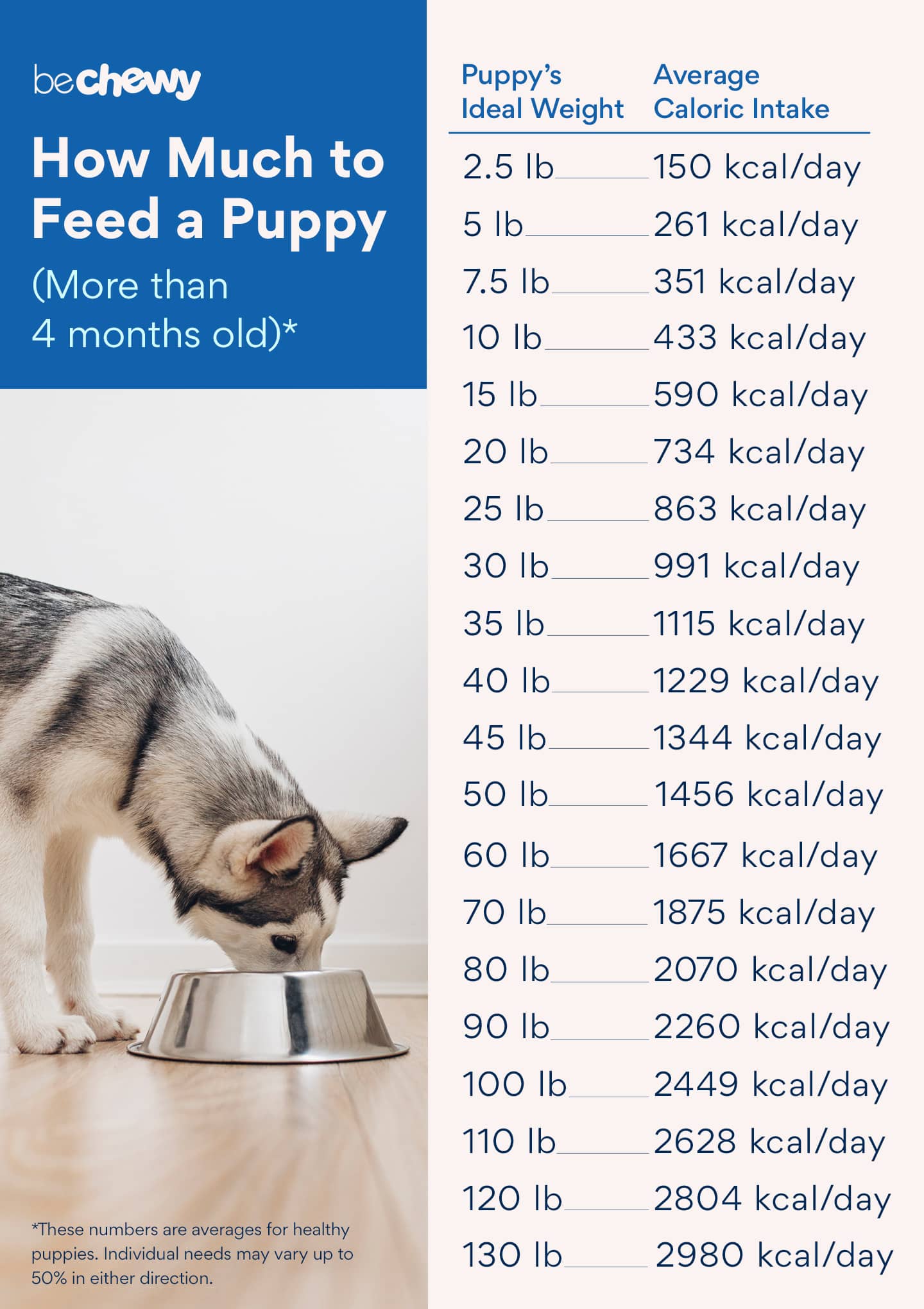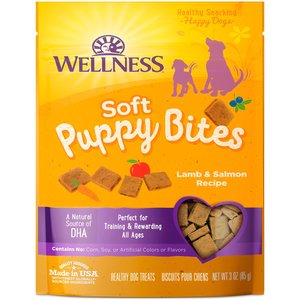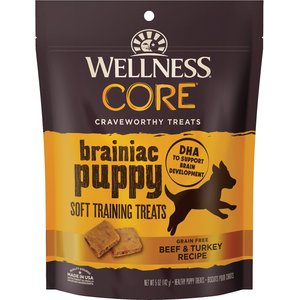While it’s always important to feed your dogs well, it’s especially important to know how much to feed a puppy, so they can get the best start in life with the proper nutrition.
Your puppy’s growing bones, muscles, brain cells and tissues require specific nutrients: Too few or too many calories, over supplementing or nutrient deficiencies—all of these can be harmful to your pup in the long run, making it vital to know how much to feed a puppy. And, no, feeding a standard dog food is not the solution as most will not fulfill these needs.
If you have found yourself to be the caregiver of a new puppy (or puppies—lucky you!), take a look through our guide below to learn how much to feed a puppy. It will help you understand your puppy’s nutritional needs through every stage of their young life—so you can help them thrive.
Feeding Puppies From Birth Through 4 Weeks of Age
The best puppy food for your puppy’s first month of life is their mother’s milk, which has the best balance of nutrients for a growing puppy.
If you are raising puppies yourself without the mother, or you need to supplement puppies for another reason, a formula specifically made for puppies is the best option. (Don’t substitute a kitten or human formula.)
Puppies should be weighed daily. While a pup may not gain weight the first day (a healthy starting weight is different for each breed and can be determined by your veterinarian), there should be steady weight gains after that. If a puppy loses weight or fails to gain, contact your veterinarian.
How to Bottle Feed Puppies
Whenever possible, puppies should be nursed and raised by their mothers. There are times, however, when bottle feeding puppies becomes necessary (such as when a pup is orphaned). But bottle feeding the wrong thing, the wrong way, the wrong amount or on the wrong schedule can lead to illness or even death.
Here is how to bottle feed puppies:
- Milk replacers designed specifically for puppies is the best alternative to mother’s milk. You’ll also need several pet nurser bottles as well as a variety of nipples.
- Reconstitute powdered milk replacer per label instructions or use a premixed variety.
- Warm the bottle by placing it in a cup of hot water until the milk reaches body temperature.
- Test the nipple before every feeding to ensure that milk only drips from the opening.
- Puppies are best fed in a belly-down position. Place the pup on your lap or on a towel on a table and insert the nipple into their mouth. Tip the bottle so that any air inside stays away from the nipple.
- Continue feeding until the puppy’s suckling stops or slows dramatically. Put a finger against the puppy’s throat to feel if they are still swallowing.
- Newborn puppies need to eat every 2 to 3 hours, but as long as they get four to five full-sized meals in the course of the day, nighttime feedings are generally not necessary.
- A 2- to 4-week-old puppy feeding schedule should consist of feedings every 6 to 8 hours.
- Young puppies must be stimulated to urinate and defecate. Wipe the area around the anus and penis or vulva with a warm, wet washcloth after every feeding.
It is usually not necessary to determine exactly how much puppies are eating as long as they gain weight daily and don’t act hungry (crying, for example) until just before the next feeding is due.
Commercially available milk replacers provide puppy feeding charts or guidelines for what a typical puppy might eat over the course of a day—for example, 2 teaspoons per 4 ounces bodyweight. Follow these closely, as puppies who drink too much at one feeding can develop diarrhea; and if you have any questions or concerns, talk to your veterinarian.
How to Wean Puppies
As for a 5-week-old puppy feeding schedule, this is around when most people will start to wean their puppies.
- For what to feed puppies who are weaning, use a commercially made, high-quality balanced food. Kibble should be softened with water or broth to a soupy texture, or you can add a little extra water to wet puppy food.
- To get the puppies interested, dip your finger into the mush and then let them lick it. Puppies quickly learn to lap up the food.
- Make sure each pup is getting their fair share. Separate dog bowls given under supervision is ideal.
- While feeding puppies your weaning mix, there is no standard set of directions for how much a puppy should eat. Continue to weigh your puppies daily. You want pups that are growing but not overweight.
- If the puppies are still nursing a bit, figure on offering them three or four meals a day as a puppy feeding schedule. Toy and small breed pups may need some extra snacks, as they are susceptible to hypoglycemia (low blood sugar).
- Nutritional weaning is complete when the puppies are eating only puppy food and no longer nursing at all. When litters and moms are kept together, pups are usually eating only puppy food at around 8 weeks of age.
Feeding Your Pup After Weaning
How Much to Feed a Puppy
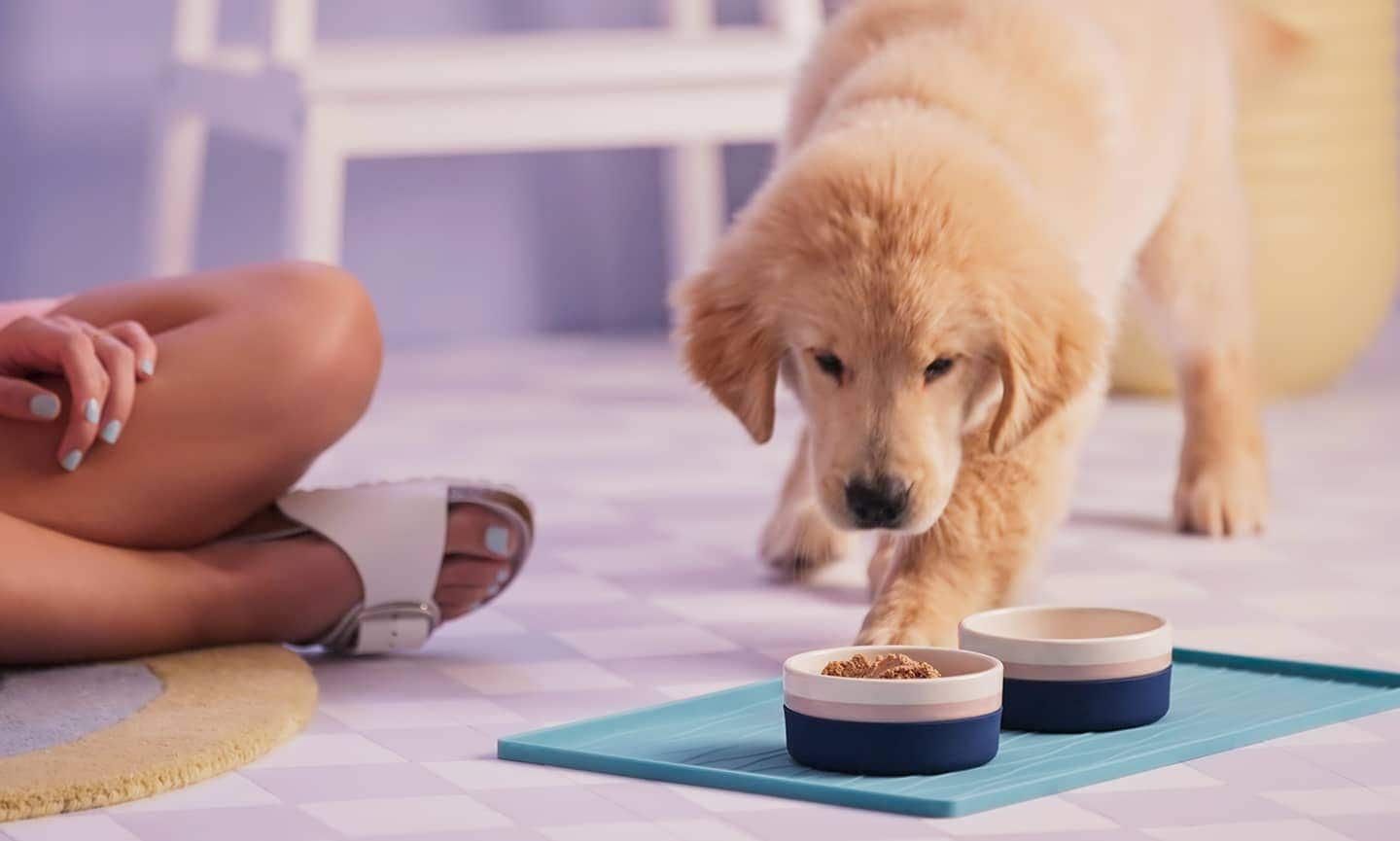
How much food you serve your puppy depends on your their age, weight and body condition score. Your dog's body condition score measures their body fat, similar to body mass index (BMI) in humans, and is best determined by your vet.
Use these charts to find an average amount of calories your dog should consume—but remember that your unique pup may need up to 50 percent more or fewer calories, depending on their body condition score.
Not great at math? Don't worry. The packaging for your pup’s dog food will have suggested feeding amounts.
It is extremely important that you follow the puppy feeding chart on your brand of puppy food, as well as the advice of your veterinarian. Your vet will make specific recommendations based on whether your pup is over or underweight, has nutritional deficiencies, is spayed or neutered, and on their activity level and other factors—all of which will affect the recommended feeding amount for puppies.
Additionally, different puppy foods all have different nutrient densities, so manufacturers’ recommendations will vary from formula to formula. For example, this is American Journey Active Life Formula Puppy Chicken, Brown Rice & Vegetables Recipe Dog Food’s feeding chart for puppies:
Weight
3 lbs.
6 lbs.
10 lbs.
15 lbs.
20 lbs.
30 lbs.
40 lbs.
50 lbs.
60 lbs.
70 lbs.
80 lbs.
Cups (ages 1.5-6 mo.)
3/4
1 1/4
1 3/4
2 1/2
3
4
5
6
6 3/4
7 2/3
8 1/2
Cups (6-1 yr)
1/2
3/4
1 1/4
1 2/3
2
2 3/4
3 1/3
4
4 2/3
5 1/4
5 2/3
It will look different than the pup feeding guidelines of another brand, because of the varying amount of ingredients and nutrients in each formula. Again, it is extremely important that you follow the feeding chart for puppies that your specific puppy food provides. Otherwise, you may over-feeding or underfeeding your poor pup!
Another important note when it comes to how much do you feed puppies: Use something to accurately measure the food, like a scale for weighing out portions or a measuring cup.
The Best Puppy Food
When you compare a puppy food to an adult dog food, you will notice some differences. Guidelines established by the AAFCO (Association of American Feed Control Officials) require more of almost every nutrient for puppy food versus adult food. The exception are some vitamins, which can easily be overdosed.
As for the type of food to feed your puppy, you can feed solid food or wet food—or both! There are many benefits of mixing wet and dry pet food: It can increase palatability, increase water intake (and a hydrated dog is a happy dog!) and help with weight management. Learn more about mixing wet and dry pet food.
Try these vet-recommended dry and wet foods for puppies:
Dog Food for Large- and Giant-Breed Puppies
Some companies have developed formulas for different groups of puppies. For large- and giant-breed puppies, the amount of calories, protein, calcium and phosphorus has to be perfect to establish a slow but steady growth and avoid any orthopedic problems. You don’t want your Great Dane to grow too fast. Many large- and giant-breed dogs don’t reach adult size until they are well over a year of age.
Try these good foods for large puppies:
Dog Food for Small- and Toy-Breed Puppies
Small- and toy-breed pups need a nutrient-dense food because they reach mature size more quickly and can’t physically eat large amounts of food.
Try these vet-recommended small breed puppy foods:
Treats for Puppies
Treats are an inevitable part of pup feeding. Limit treats to 10 percent or less of their diet, otherwise you may go over how much should a puppy eat. Stick to healthy dog treats made for puppies or training treats (and no table scraps!).
Try these puppy treats:
Puppy Feeding Schedule
When it comes to daily feeding, don’t fall into the trap of always leaving food down: This can increase your puppy’s chances of overeating. (Although your dog should always have access to fresh water up to an hour or two before bedtime.) Feed your puppy the specified quantities set by your vet and your puppy’s food label at mealtimes, so you know exactly when your puppy last ate and how much.
Most puppies do best with three meals a day until 6 months of age, then switching over to two meals a day. For toy- and small-breed dogs, four meals a day until 6 months, then three meals a day may be best. Ask your vet about a specific feeding schedule to ensure you're meeting your dog's unique needs.
Learn more about how often you should be feeding your puppy here.
When Can a Puppy Eat Adult Dog Food?
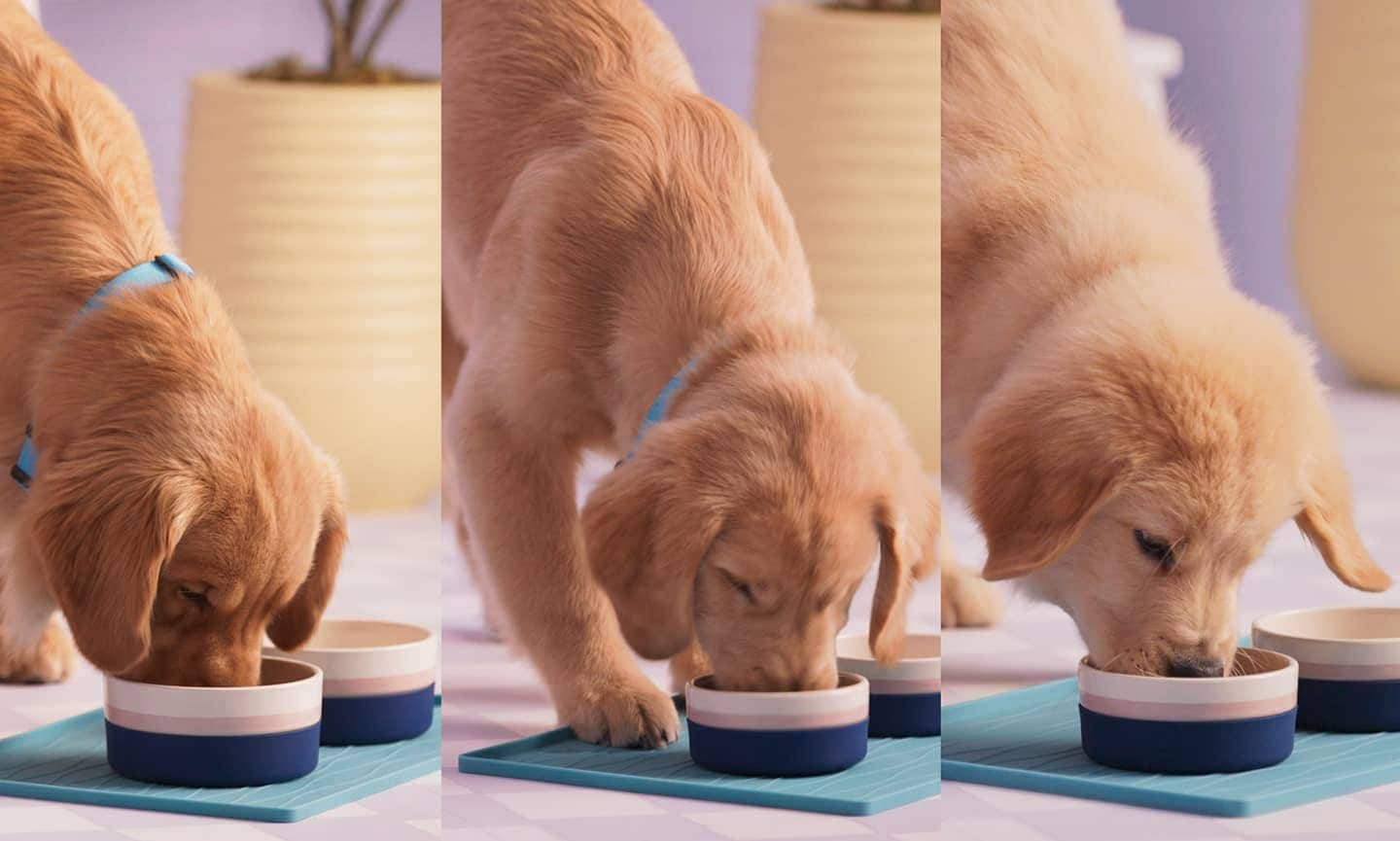
When to shift your pup over to adult dog food will depend partly on their size and growth rate. Many toy- and small-breed dogs and mixed breeds reach their full size by 10 to 12 months of age. While a very active small dog may benefit from an extra snack during the day, they can start the change to an adult diet. Large- and giant-breed dogs may not reach full growth until 18 months or older.
Consult your veterinarian for guidance about switching to adult dog food.
FAQs about Puppy Feeding
Q: What do I feed a puppy with coccidia?
A: Coccidiosis is an intestinal infection caused by a small single-celled organism called coccidia. Puppies infected with coccidia can show a range of clinical signs. Some are asymptomatic with infection discovered on a routine fecal exam. Others may be more severely affected, showing signs of diarrhea (sometimes with blood), inappetence, lethargy, abdominal pain and discomfort.
Treatment typically involves administration of a prescription antibiotic to rid the body of the organism. In severely affected puppies more intensive type care may be needed.
If the puppy is asymptomatic, they may continue to eat their normal puppy diet. Dietary changes may only be needed when the puppy has experienced significant digestive upset. In those cases, a bland low fat easily digestible diet, like Purina Pro Plan Puppy Sensitive Skin & Stomach Dry Dog Food, may be recommended. If the puppy has lost weight a more calorie-dense diet may be used in the short term. The right diet will depend on how badly the puppy was infected and how their gut is recovering. Most puppies will be able to transition back to regular puppy food over time.
Q: What do I feed a puppy with upset stomach?
A: There are many potential causes for upset stomach in puppies.
They love to explore their new environment through their mouths, which can lead to ingestion of non-food items causing stomach upset. Sudden vomiting and diarrhea may also be caused by a new food or treat, diet change, a blockage of the digestive tract, intestinal parasites, infections with bacteria or viruses, exposure to toxins, or disease affecting other organ systems.
Some cases are mild while others can be severe to life threatening. It’s best to work with your veterinarian to determine the cause for stomach upset in your puppy.
- In some cases, a bland diet lower in fat that is easily digestible diet may be recommended. (Try Purina Pro Plan Puppy Sensitive Skin & Stomach Dry Dog Food.) For sudden stomach upset due to simple causes this can often help.
- This may be a prescription diet from the vet, like Royal Canin Veterinary Diet Gastrointestinal Puppy Dry Dog Food, offered in smaller more frequent meals for a few days.
- If digestive issues resolve, a gradual transition back to the regular puppy food diet can usually happen. A probiotic is sometimes prescribed to aid in digestion.
- If your veterinarian suspects food intolerance as a cause for continued stomach upset (or other signs), they may suggest trying a hypoallergenic diet, like Royal Canin Veterinary Diet Hydrolyzed Protein HP Dry Dog Food, or a diet with limited ingredients.
Q: What do I feed a puppy with parvo?
A: Parvovirus infects the intestinal tract of puppies. It can lead to severe signs, including vomiting, diarrhea with blood, lethargy, inappetence and abdominal discomfort.
Most puppies affected with parvovirus require care intensive care in the hospital. Some may be amenable to outpatient care if their signs are mild.
Keeping up with the puppy’s hydration and nutritional requirements are a key part to managing their disease and helping them recover. This may be done in one of several ways during a hospital stay:
- Nutrition may be given through a feeding tube and in some cases through an intravenous catheter (parenteral nutrition).
- Some puppies may be amenable to small frequent meals via syringe feeding.
- The puppy will likely be sent home with a prescription diet that is bland, low fat and easily digestible diet. Some may require a more calorie-dense critical care recovery diet, such as Purina Pro Plan Veterinary Diets CN Critical Nutrition Formula Canned Dog & Cat Food.
- Once recovered, most can transition back to regular puppy food.
More Pro Puppy Tips:
Share:



